Christopher Pal
Poutine: Vision-Language-Trajectory Pre-Training and Reinforcement Learning Post-Training Enable Robust End-to-End Autonomous Driving
Jun 12, 2025Abstract:We present Poutine, a 3B-parameter vision-language model (VLM) tailored for end-to-end autonomous driving in long-tail driving scenarios. Poutine is trained in two stages. To obtain strong base driving capabilities, we train Poutine-Base in a self-supervised vision-language-trajectory (VLT) next-token prediction fashion on 83 hours of CoVLA nominal driving and 11 hours of Waymo long-tail driving. Accompanying language annotations are auto-generated with a 72B-parameter VLM. Poutine is obtained by fine-tuning Poutine-Base with Group Relative Policy Optimization (GRPO) using less than 500 preference-labeled frames from the Waymo validation set. We show that both VLT pretraining and RL fine-tuning are critical to attain strong driving performance in the long-tail. Poutine-Base achieves a rater-feedback score (RFS) of 8.12 on the validation set, nearly matching Waymo's expert ground-truth RFS. The final Poutine model achieves an RFS of 7.99 on the official Waymo test set, placing 1st in the 2025 Waymo Vision-Based End-to-End Driving Challenge by a significant margin. These results highlight the promise of scalable VLT pre-training and lightweight RL fine-tuning to enable robust and generalizable autonomy.
Rendering-Aware Reinforcement Learning for Vector Graphics Generation
May 27, 2025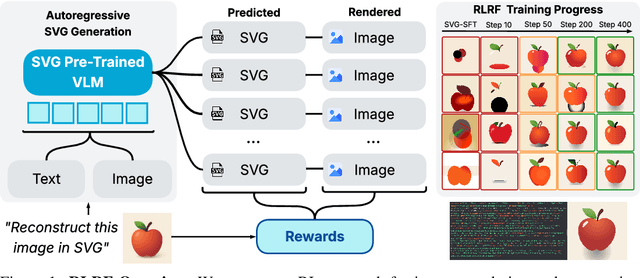
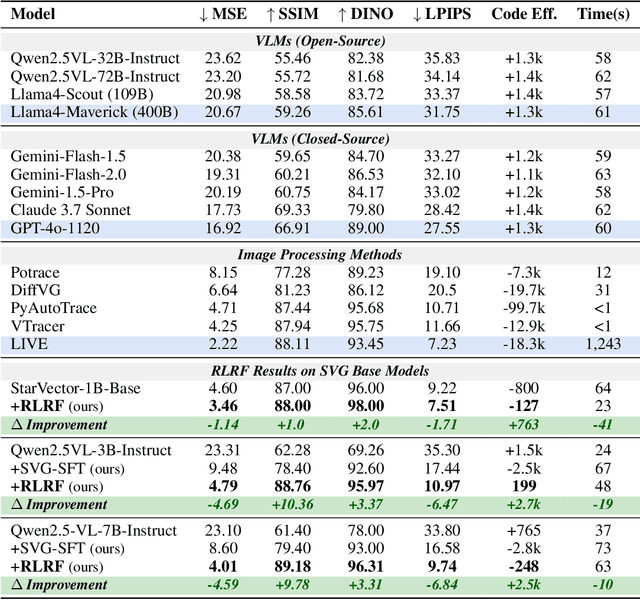

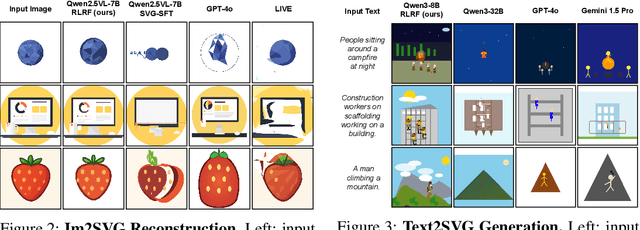
Abstract:Scalable Vector Graphics (SVG) offer a powerful format for representing visual designs as interpretable code. Recent advances in vision-language models (VLMs) have enabled high-quality SVG generation by framing the problem as a code generation task and leveraging large-scale pretraining. VLMs are particularly suitable for this task as they capture both global semantics and fine-grained visual patterns, while transferring knowledge across vision, natural language, and code domains. However, existing VLM approaches often struggle to produce faithful and efficient SVGs because they never observe the rendered images during training. Although differentiable rendering for autoregressive SVG code generation remains unavailable, rendered outputs can still be compared to original inputs, enabling evaluative feedback suitable for reinforcement learning (RL). We introduce RLRF(Reinforcement Learning from Rendering Feedback), an RL method that enhances SVG generation in autoregressive VLMs by leveraging feedback from rendered SVG outputs. Given an input image, the model generates SVG roll-outs that are rendered and compared to the original image to compute a reward. This visual fidelity feedback guides the model toward producing more accurate, efficient, and semantically coherent SVGs. RLRF significantly outperforms supervised fine-tuning, addressing common failure modes and enabling precise, high-quality SVG generation with strong structural understanding and generalization.
Distilling semantically aware orders for autoregressive image generation
Apr 23, 2025Abstract:Autoregressive patch-based image generation has recently shown competitive results in terms of image quality and scalability. It can also be easily integrated and scaled within Vision-Language models. Nevertheless, autoregressive models require a defined order for patch generation. While a natural order based on the dictation of the words makes sense for text generation, there is no inherent generation order that exists for image generation. Traditionally, a raster-scan order (from top-left to bottom-right) guides autoregressive image generation models. In this paper, we argue that this order is suboptimal, as it fails to respect the causality of the image content: for instance, when conditioned on a visual description of a sunset, an autoregressive model may generate clouds before the sun, even though the color of clouds should depend on the color of the sun and not the inverse. In this work, we show that first by training a model to generate patches in any-given-order, we can infer both the content and the location (order) of each patch during generation. Secondly, we use these extracted orders to finetune the any-given-order model to produce better-quality images. Through our experiments, we show on two datasets that this new generation method produces better images than the traditional raster-scan approach, with similar training costs and no extra annotations.
AgentAda: Skill-Adaptive Data Analytics for Tailored Insight Discovery
Apr 10, 2025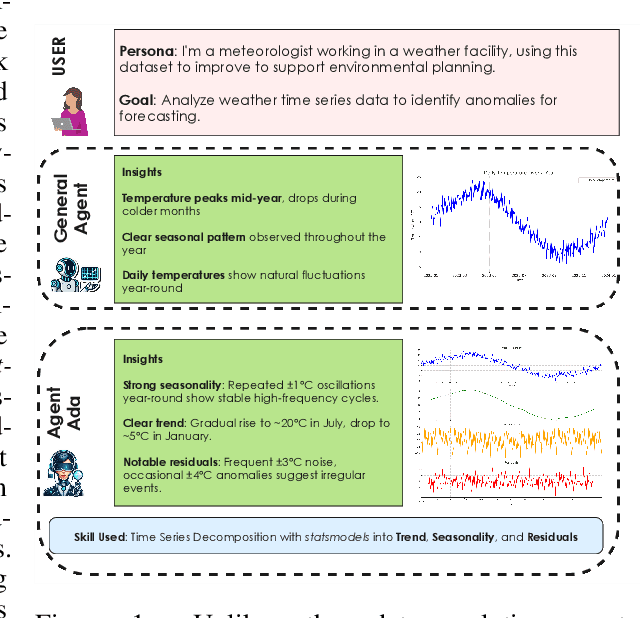

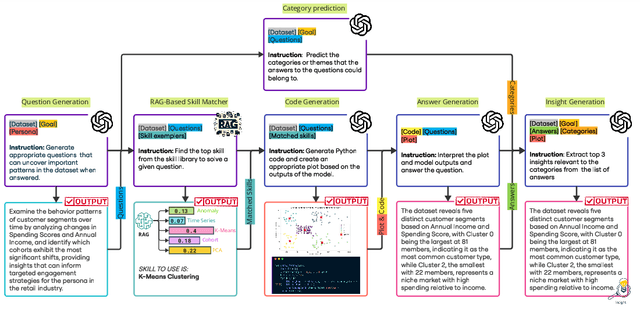

Abstract:We introduce AgentAda, the first LLM-powered analytics agent that can learn and use new analytics skills to extract more specialized insights. Unlike existing methods that require users to manually decide which data analytics method to apply, AgentAda automatically identifies the skill needed from a library of analytical skills to perform the analysis. This also allows AgentAda to use skills that existing LLMs cannot perform out of the box. The library covers a range of methods, including clustering, predictive modeling, and NLP techniques like BERT, which allow AgentAda to handle complex analytics tasks based on what the user needs. AgentAda's dataset-to-insight extraction strategy consists of three key steps: (I) a question generator to generate queries relevant to the user's goal and persona, (II) a hybrid Retrieval-Augmented Generation (RAG)-based skill matcher to choose the best data analytics skill from the skill library, and (III) a code generator that produces executable code based on the retrieved skill's documentation to extract key patterns. We also introduce KaggleBench, a benchmark of curated notebooks across diverse domains, to evaluate AgentAda's performance. We conducted a human evaluation demonstrating that AgentAda provides more insightful analytics than existing tools, with 48.78% of evaluators preferring its analyses, compared to 27.67% for the unskilled agent. We also propose a novel LLM-as-a-judge approach that we show is aligned with human evaluation as a way to automate insight quality evaluation at larger scale.
Scenario Dreamer: Vectorized Latent Diffusion for Generating Driving Simulation Environments
Mar 28, 2025Abstract:We introduce Scenario Dreamer, a fully data-driven generative simulator for autonomous vehicle planning that generates both the initial traffic scene - comprising a lane graph and agent bounding boxes - and closed-loop agent behaviours. Existing methods for generating driving simulation environments encode the initial traffic scene as a rasterized image and, as such, require parameter-heavy networks that perform unnecessary computation due to many empty pixels in the rasterized scene. Moreover, we find that existing methods that employ rule-based agent behaviours lack diversity and realism. Scenario Dreamer instead employs a novel vectorized latent diffusion model for initial scene generation that directly operates on the vectorized scene elements and an autoregressive Transformer for data-driven agent behaviour simulation. Scenario Dreamer additionally supports scene extrapolation via diffusion inpainting, enabling the generation of unbounded simulation environments. Extensive experiments show that Scenario Dreamer outperforms existing generative simulators in realism and efficiency: the vectorized scene-generation base model achieves superior generation quality with around 2x fewer parameters, 6x lower generation latency, and 10x fewer GPU training hours compared to the strongest baseline. We confirm its practical utility by showing that reinforcement learning planning agents are more challenged in Scenario Dreamer environments than traditional non-generative simulation environments, especially on long and adversarial driving environments.
StarFlow: Generating Structured Workflow Outputs From Sketch Images
Mar 27, 2025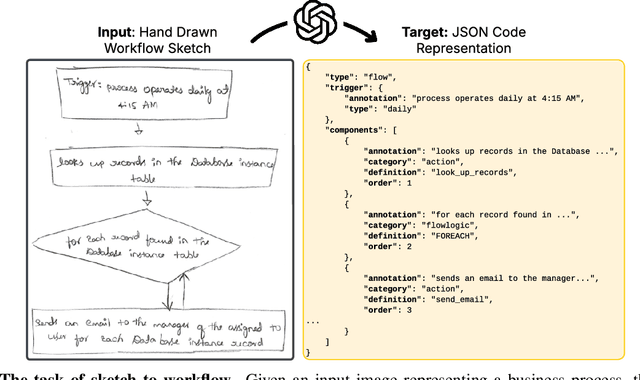


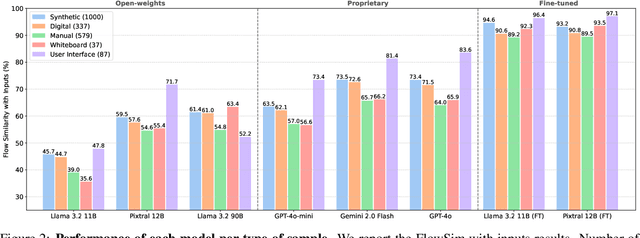
Abstract:Workflows are a fundamental component of automation in enterprise platforms, enabling the orchestration of tasks, data processing, and system integrations. Despite being widely used, building workflows can be complex, often requiring manual configuration through low-code platforms or visual programming tools. To simplify this process, we explore the use of generative foundation models, particularly vision-language models (VLMs), to automatically generate structured workflows from visual inputs. Translating hand-drawn sketches or computer-generated diagrams into executable workflows is challenging due to the ambiguity of free-form drawings, variations in diagram styles, and the difficulty of inferring execution logic from visual elements. To address this, we introduce StarFlow, a framework for generating structured workflow outputs from sketches using vision-language models. We curate a diverse dataset of workflow diagrams -- including synthetic, manually annotated, and real-world samples -- to enable robust training and evaluation. We finetune and benchmark multiple vision-language models, conducting a series of ablation studies to analyze the strengths and limitations of our approach. Our results show that finetuning significantly enhances structured workflow generation, outperforming large vision-language models on this task.
UI-Vision: A Desktop-centric GUI Benchmark for Visual Perception and Interaction
Mar 19, 2025Abstract:Autonomous agents that navigate Graphical User Interfaces (GUIs) to automate tasks like document editing and file management can greatly enhance computer workflows. While existing research focuses on online settings, desktop environments, critical for many professional and everyday tasks, remain underexplored due to data collection challenges and licensing issues. We introduce UI-Vision, the first comprehensive, license-permissive benchmark for offline, fine-grained evaluation of computer use agents in real-world desktop environments. Unlike online benchmarks, UI-Vision provides: (i) dense, high-quality annotations of human demonstrations, including bounding boxes, UI labels, and action trajectories (clicks, drags, and keyboard inputs) across 83 software applications, and (ii) three fine-to-coarse grained tasks-Element Grounding, Layout Grounding, and Action Prediction-with well-defined metrics to rigorously evaluate agents' performance in desktop environments. Our evaluation reveals critical limitations in state-of-the-art models like UI-TARS-72B, including issues with understanding professional software, spatial reasoning, and complex actions like drag-and-drop. These findings highlight the challenges in developing fully autonomous computer use agents. By releasing UI-Vision as open-source, we aim to advance the development of more capable agents for real-world desktop tasks.
AlignVLM: Bridging Vision and Language Latent Spaces for Multimodal Understanding
Feb 03, 2025



Abstract:Aligning visual features with language embeddings is a key challenge in vision-language models (VLMs). The performance of such models hinges on having a good connector that maps visual features generated by a vision encoder to a shared embedding space with the LLM while preserving semantic similarity. Existing connectors, such as multilayer perceptrons (MLPs), often produce out-of-distribution or noisy inputs, leading to misalignment between the modalities. In this work, we propose a novel vision-text alignment method, AlignVLM, that maps visual features to a weighted average of LLM text embeddings. Our approach leverages the linguistic priors encoded by the LLM to ensure that visual features are mapped to regions of the space that the LLM can effectively interpret. AlignVLM is particularly effective for document understanding tasks, where scanned document images must be accurately mapped to their textual content. Our extensive experiments show that AlignVLM achieves state-of-the-art performance compared to prior alignment methods. We provide further analysis demonstrating improved vision-text feature alignment and robustness to noise.
LLMs for Literature Review: Are we there yet?
Dec 15, 2024



Abstract:Literature reviews are an essential component of scientific research, but they remain time-intensive and challenging to write, especially due to the recent influx of research papers. This paper explores the zero-shot abilities of recent Large Language Models (LLMs) in assisting with the writing of literature reviews based on an abstract. We decompose the task into two components: 1. Retrieving related works given a query abstract, and 2. Writing a literature review based on the retrieved results. We analyze how effective LLMs are for both components. For retrieval, we introduce a novel two-step search strategy that first uses an LLM to extract meaningful keywords from the abstract of a paper and then retrieves potentially relevant papers by querying an external knowledge base. Additionally, we study a prompting-based re-ranking mechanism with attribution and show that re-ranking doubles the normalized recall compared to naive search methods, while providing insights into the LLM's decision-making process. In the generation phase, we propose a two-step approach that first outlines a plan for the review and then executes steps in the plan to generate the actual review. To evaluate different LLM-based literature review methods, we create test sets from arXiv papers using a protocol designed for rolling use with newly released LLMs to avoid test set contamination in zero-shot evaluations. We release this evaluation protocol to promote additional research and development in this regard. Our empirical results suggest that LLMs show promising potential for writing literature reviews when the task is decomposed into smaller components of retrieval and planning. Further, we demonstrate that our planning-based approach achieves higher-quality reviews by minimizing hallucinated references in the generated review by 18-26% compared to existing simpler LLM-based generation methods.
BigDocs: An Open and Permissively-Licensed Dataset for Training Multimodal Models on Document and Code Tasks
Dec 05, 2024



Abstract:Multimodal AI has the potential to significantly enhance document-understanding tasks, such as processing receipts, understanding workflows, extracting data from documents, and summarizing reports. Code generation tasks that require long-structured outputs can also be enhanced by multimodality. Despite this, their use in commercial applications is often limited due to limited access to training data and restrictive licensing, which hinders open access. To address these limitations, we introduce BigDocs-7.5M, a high-quality, open-access dataset comprising 7.5 million multimodal documents across 30 tasks. We use an efficient data curation process to ensure our data is high-quality and license-permissive. Our process emphasizes accountability, responsibility, and transparency through filtering rules, traceable metadata, and careful content analysis. Additionally, we introduce BigDocs-Bench, a benchmark suite with 10 novel tasks where we create datasets that reflect real-world use cases involving reasoning over Graphical User Interfaces (GUI) and code generation from images. Our experiments show that training with BigDocs-Bench improves average performance up to 25.8% over closed-source GPT-4o in document reasoning and structured output tasks such as Screenshot2HTML or Image2Latex generation. Finally, human evaluations showed a preference for outputs from models trained on BigDocs over GPT-4o. This suggests that BigDocs can help both academics and the open-source community utilize and improve AI tools to enhance multimodal capabilities and document reasoning. The project is hosted at https://bigdocs.github.io .
 Add to Chrome
Add to Chrome Add to Firefox
Add to Firefox Add to Edge
Add to Edge